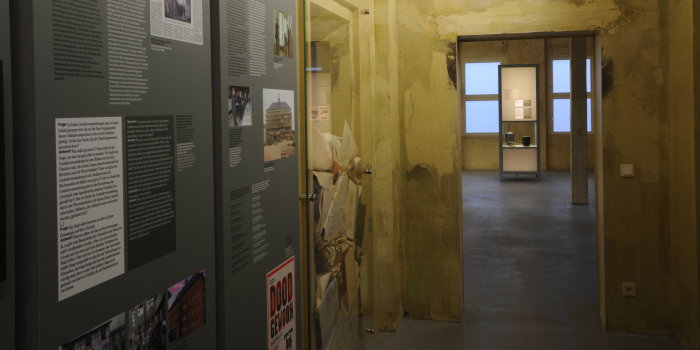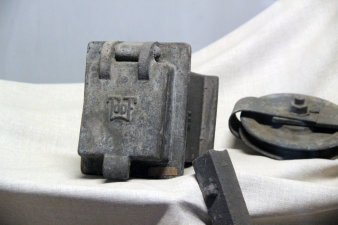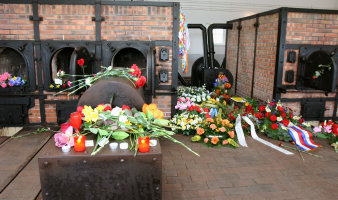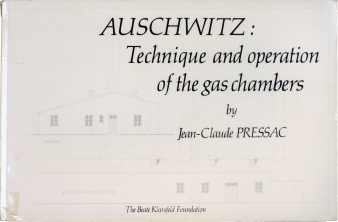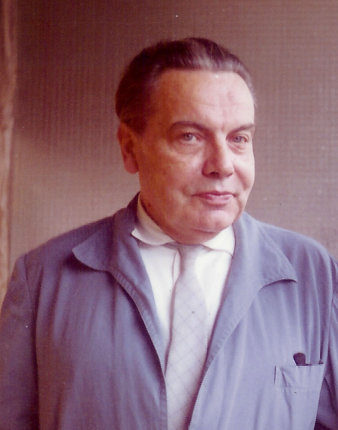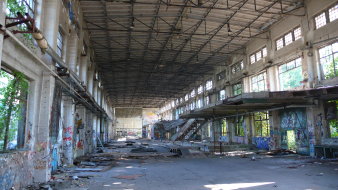Preservation of Evidence - Commemoration - Denial
As early as the summer of 1944, the SS endeavoured to eliminate all evidence of murder in Auschwitz. It killed witnesses, such as the inmates of the Sonderkommando, shredded documents and gave orders for ditches in which corpses had been burned or bone residue had been buried to be filled in by inmates, and the surfaces replanted. On January 20, 1945, the SS blew up Crematoria II and III. Crematorium IV, which had partially caved in during the revolt by the Sonderkommando, had already been dismantled in mid October 1944. In Crematorium V the SS carried out executions and burned corpses until the very end. The crematorium was not blown up until one day before the camp's liberation.
Soldiers of the Red Army reached Auschwitz on January 27, 1945. In depots the SS had no longer been able to destroy, the liberators found evidence of mass murder, among other things vast amounts of clothing, shoes, artificial limbs and human hair. The ruins of the crematoria now became a focus of initial investigations. Members of a Soviet and a Polish committee of investigation had surviving inmates explain the operation of the extermination facilities to them and evaluated files and documents that had been found.
The Soviet investigating committee submitted its final report in early May 1945. As a representative of the company Topf & Sons, Kurt Prüfer was very high on the list of fifty persons for whom severe punishment was demanded.
Today the former camp crematoria and their ruins are central places of mourning and commemoration. Symbolically they stand for the non-existing graves of the countless victims. It is here that the descendants lay stones, flowers and wreaths. At the same time, the sites are also evidence of the extermination. Again and again, deniers of the National Socialist crimes have claimed that there were no gas chambers, and that no mass murder – in particular the Holocaust – took place. They dispute the function of the crematoria as extermination facilities or question the technical feasibility of killing and burning so many human beings there.
The National Socialist crimes can be proven on the basis of numerous sources. Yet the sources concerning the construction history and technology of the crematoria as extermination facilities long went unnoticed. It was not until the 1980s that research was undertaken on this subject. In the process, Topf & Son's involvement in the crimes of the SS came increasingly into the limelight. Jean-Claude Pressac, a pharmacist of Paris and originally a Holocaust denier, was one of the first to study the files of the Central Construction Management of Auschwitz and the technical details of the crematoria. On the basis of his investigations, he came to the conclusion that the mass murder in the crematoria of Auschwitz was technically possible and had indeed taken place. He also looked for the Topf & Sons company archives, a source of no interest to anyone in Erfurt at the time. According to Pressac himself, the management of the company – which had continued operations in the German Democratic Republic and in the meantime been reprivatized – gave him the documents. Only after Pressac's death in 2003 did his friends and relatives succeed in having the archives returned to Germany, where they were placed in the collection of the Thuringian Main State Archives in Weimar. Now accessible to the public, these documents serve as a new foundation for research on Topf & Sons
As was common practise, the Topf & Sons assembly teams attached their company nameplates to the incineration ovens they had installed. After the liberation of Buchenwald Concentration Camp on April 11, 1945, these nameplates led American investigators to Erfurt.
They arrested Kurt Prüfer. Two weeks later, he had already been released and was back at work at Topf & Sons. In July 1945, Thuringia was declared part of the Soviet-occupied zone. In March 1946 four leading employees of Topf & Sons were arrested: Kurt Prüfer, Gustav Braun, Fritz Sander and Karl Schultze. Prüfer, whose key role in the creation of the "death factories" had already been established in May 1945 by the Soviet investigating committee in Auschwitz, was interrogated in Berlin and Moscow. He was confronted with statements by former inmates and documents found in Auschwitz.
Kurt Prüfer did not deny his actions, but exhibited no feelings of guilt:
Question: Did you yourself know the purpose for which the company was building crematoria and gas chambers in the concentration camps?
Answer: Until 1943* I knew nothing about the true purpose of the crematoria in the concentration camps; I first learned about it after I had travelled to the concentration camp at Auschwitz. Before that time, the representatives of the SS construction authorities who carried out negotiations with the "TOPF" firm had always explained that the crematoria in the concentration camps had been built for the cremation of inmates who had died a natural death as a result of epidemic diseases.... I should like to emphasize at the same time that the "TOPF" company did not build gas chambers in concentration camps. All I am aware of is that two ventilation facilities for the gas chambers in the Auschwitz Concentration Camp were installed by the "TOPF" company.
Question: What concrete information did you learn about the true purpose of the crematoria and gas chambers in the Auschwitz Concentration Camp when you visited the camp in 1943?
Answer: During my visit to the Auschwitz Concentration Camp in 1943 I discovered that a mass annihilation of human beings, including women, children and old people, was taking place.... The inmates brought to Auschwitz were sent by SS men to the gas chamber, where they were killed; their bodies were then burned in crematoria and in special furnaces.
Question: That means that while you were working on the construction of incineration ovens for the Auschwitz Concentration Camp, you already knew that they were being built to exterminate innocent people?
Answer: Yes, I knew that.
* Kurt Prüfer had already learned of the gas
murders in Auschwitz in the spring of 1942.
Kurt Prüfer during interrogation in Moscow, February 11, 1948
In 1948 he was sentenced to twenty-five years in a penal colony for aiding and abetting "crimes against the civilian population and captive members of the Red Army." According to Soviet sources he died of a stroke in October 1952. Fritz Sander died a few weeks after his arrest of a heart condition. Like Prüfer, Gustav Braun and Karl Schultze were sentenced to twenty-five years in a penal colony; the latter two were released in 1955.
Kurt Prüfer's arrest on May 30, 1945 led Ludwig Topf to fear arrest himself. That same evening, he decided to commit suicide. In a farewell letter he cast himself in the role of a person guilty of nothing and wrongly persecuted. He disinherited his brother Ernst-Wolfgang and his sister Hanna who, he felt, had abandoned him. On the morning of May 31, 1945, at the age of 41, Ludwig Topf committed suicide by taking poison.
Farewell letter by Ludwig Topf, May 30, 1945 (excerpt, underlining in original)
If I have made the decision to evade arrest it is for the following reason: I have lost all belief in any law in this world now that my family has also done me so much wrong and harm. If I am arrested, the greatest of all wrongs will be done to me. I never consciously or intentionally did anything bad; instead it has been done to me. I was never cowardly – but I was proud. Handing myself over to the mercy or mercilessness of a foreign country is something I cannot do, because I have learnt the bitter lesson that there is no law and no decency left in this world. That is why I, as a decent person, today have one remaining opportunity to determine my fate as I see fit. And that means immediate departure from a world that in general has become unbearable, and in particular has persecuted and wronged me.
If I ever believed that my innocence as far as the crematoria are concerned (and my brother is just as innocent) would be recognized and honoured, I would continue to fight for justification, as I always have until now – but I think people need a sacrifice. In which case the least I can do is provide it myself. I was always decent – the opposite of a Nazi – the whole world knows that. If I were still able to feel at peace in the heart of a family, the struggle would be worthwhile – but the Topf family that showed composure, integrity and self-confidence has ceased to exist. I was its sole representative as far as that was concerned. Indeed I am so alone that I have no need to ask anyone's forgiveness, not even for a suicide.
Ernst Wolfgang Topf, who had travelled to the west before the change of occupation in June 1945, was not granted permission from the Soviet authorities to return. He tried to re-establish the firm of Topf & Sons in Wiesbaden. In contrast to the company in Erfurt, however, the main emphasis was now to be on the construction of crematory and refuse incineration ovens. This sector evidently seemed to Ernst Wolfgang Topf to offer the greatest prospects of success.
Ernst Wolfgang Topf’s past caught up with him, however. In 1957 the journalist Reimund Schnabel published his book "Macht ohne Moral. Eine Dokumentation über die SS" (Power without Morality. A Documentary Account of the SS). It contained printed copies of two Topf & Sons documents providing evidence of the firm's dealings with the SS. Ernst Wolfgang Topf responded with a multi-page denial in which he disputed the authenticity of the documents and maintained that "in our company, no-one was guilty, either morally or objectively. It is accordingly not a mere empty phrase if I use the words "Morality Without Power" to characterize my company and my entire behaviour in the twelve years of the Hitler Reich." For the remainder of his life he remained stubbornly convinced that the products of Topf & Sons had been misused in an unforeseeable manner, and clung to his concept of "innocent ovens."
From the very beginning, Ernst Wolfgang Topf had difficulties developing his newly re-founded firm. The publication of the two documents by Reimund Schnabel was one factor which contributed to his failure to attain economic stability.
Ernst Wolfgang Topf was never prosecuted. A trial by a denazification tribunal came to nothing, as did preliminary proceedings against him as an accessory to murder by the Wiesbaden public prosecutor's office.
Although he ultimately specialized in the design and construction of technically unsophisticated refuse incineration ovens, his enterprise went bankrupt in 1963. On February 23, 1979, Ernst Wolfgang Topf died in Brilon at the age of 74.
When the company of Topf & Sons came under suspicion after the liberation of Buchenwald Concentration Camp, its management was quick to react. Ludwig Topf organized a meeting with the works council on April 27, 1945 for the purpose of formulating a standardized response with regard to the concentration camp business. He explained his action by noting that "it is quite possible that you will also be questioned about the matter." As a line of justification he stipulated that the business relationship with the SS had been a perfectly normal one, and that the company had merely supplied the camps with nothing but standard cremation ovens. Furthermore, they had only been obeying orders, and had even prevented worse things from happening – more specifically, they had prevented epidemics. The works council shared this viewpoint and thus saw no cause for concern.
In late November 1945, Sander's patent application for the "continuous-operation corpse incineration oven for mass use" was even mentioned in a list of patents and patent applications submitted by the company to the "Thuringian Administration Office in Erfurt" for the estimation of its assets.
In June 1945, following a brief shutdown, Topf & Sons was already permitted to resume operations with the production of facilities for the foodstuffs industry. After the Red Army arrived in the summer of 1945, field kitchens and other reparation goods were manufactured. The company was categorized as "unclaimed" and expropriated in 1947. In the 1950s, the construction of crematorium ovens was taken over by a state-owned company (Volkseigener Betrieb, or VEB) in Zwickau.
In the GDR, to the extent that any interest was expressed there in the history of Topf & Sons – now the "VEB Erfurter Mälzerei- und Speicherbau" (Erfurt Oasthouse and Granary Construction) – all blame and responsibility was laid on the former capitalist owners. Despite the GDR's professed anti-Fascist self-conception, the company's history was ignored until 1990.
Although citizens of Erfurt as well as members of the Topf family were committed to preserving the buildings as a site of concrete memory and critical examination of the past, the company grounds fell into decay. In the city of Erfurt there was evidently still a lack of awareness regarding the importance of this chapter of its history. In late 2003, major parts of the vacant industrial facilities were designated official landmarks on account of their historical significance.

